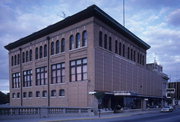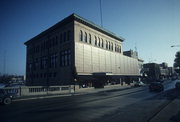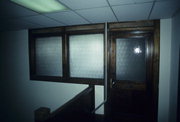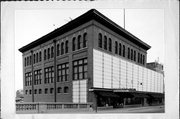Property Record
2 E MAIN ST
Architecture and History Inventory
| Historic Name: | Masonic Temple |
|---|---|
| Other Name: | Fischer Department Store |
| Contributing: | Yes |
| Reference Number: | 76210 |
| Location (Address): | 2 E MAIN ST |
|---|---|
| County: | Jefferson |
| City: | Watertown |
| Township/Village: | |
| Unincorporated Community: | |
| Town: | |
| Range: | |
| Direction: | |
| Section: | |
| Quarter Section: | |
| Quarter/Quarter Section: |
| Year Built: | 1905 |
|---|---|
| Additions: | 1916 |
| Survey Date: | 19862020 |
| Historic Use: | social recreational/fraternal hall |
| Architectural Style: | Romanesque Revival |
| Structural System: | |
| Wall Material: | Brick |
| Architect: | H.C. Koch and Sons |
| Other Buildings On Site: | |
| Demolished?: | No |
| Demolished Date: |
| National/State Register Listing Name: | Main Street Commercial Historic District |
|---|---|
| National Register Listing Date: | 1/7/1998 |
| State Register Listing Date: | 7/17/1997 |
| National Register Multiple Property Name: |
| Additional Information: | A 'site file' exists for this property. It contains additional information such as correspondence, newspaper clippings, or historical information. It is a public record and may be viewed in person at the State Historical Society, Division of Historic Preservation. This building was constructed by the Masonic fraternal order in 1905, substantially rebuilt in 1916. The Masons organized in Watertown during the 1850s and by the turn of the century, there were five Masonic groups in the city. At first the Masons met in the old Bank of Watertown building (demolished) and at Cole's Hall, but in 1905 they built this large building. In 1916 it burned and was substantially rebuilt. The Masons, like other organizations of this type declined in the twentieth century, but they still meet and have a newer lodge on E. Madison St. This building also housed a confectionary, a book store, a grocery, and a dry goods store. In its offices upstairs it was the long-time office for the Kading and Kading law firm. Charles and Elizabeth Kading were teachers when they met and decided to attend law school. They graduated in 1900, were married and set up practice in Watertown. They were successful attorneys and Charles Kading branched out into politics, serving as mayor and congressman. Elizabeth Kading was considered an outstanding trial attorney but after her son was born became primarily an office counsel. She did, though, serve as President of the Board of Control and the State Civil Service Commission before she died in an auto accident in 1925. Charles Kading continued to practice law here with his son, Charles E. Kading well into the mid-twentieth century. This building is significant for local history under National Register criterion A and B for its association with an important fraternal organization and retail businesses, and its association with two prominent individuals in the field of law. The Masons were one of the oldest and certainly the most prominent of the fraternal groups in Watertown. They constructed this building as a symbol of their importance in the community, as no other group, other than the Elks when they remodeled their Concordia Hall in 1917, achieved such a large physical reminder of their organization in the community. As other fraternal groups declined and disappeared in the twentieth century, the Masons continued to operate and maintain their group today. As the home of several retail businesses, this building is also contributing to the overall development of commerce in the Main Street Commercial historic district. Especially important is the long-time location of the Fischer Department Store, still in operation today and the second largest department store in town today. While historically Fischer's was not as significant as Schempf's or Platz and Brandt's, it is significant for its longevity beyond the 1930s and its importance in the community today. Finally, this building has significance as the workplace of Charles and ELizabeth Kading. Charles Kading was an attorney who achieved additional importance in the community as a mayor and congressman. As mayor he was said to be progressive and to have brought reforms into the community during this important era. He remained a prominent attorney into the mid-twentieth century. His wife, Elizabeth Kading, is significant as the only known woman attorney in Watertown during the historic era, and as a prominent lawyer in her own right. In fact, Charles Kading had often said it was his wife that made their firm successful. While she had to curtail her activities somewhat after the birth of their child, she was active in state wide afairs on the Board of Control and the Civil Service Board, indicating a desire to pursue progressive ideals with her husband. Her untimely death probably cut short an outstanding career in the mid-twentieth century. Their son, Charles E. Kading continued the family tradition with his prominent career as an attorney and judge in the mid and late twentieth century. A massive appearing, rust colored brick block, the Masonic Temple combines the broad projecting Italianate cornice ornamented by modillions and a row of dentils with an arcade of keystone accented 3rd story, round arched windows usually associated with the Romanesque Revival style into an early 20th century intepretation of a historic building style. Large multipaned rectangular windows are on the second story of the west elevation, separated from the third story by a recessed brick panel. Segmental arched half-windows are located on the first story of the west elevation. The cream brick rear elevation is characterized by segmental arched windows and a metal stairway to the 3rd floor. The former Masonic Temple Building has been altered by the addition of modern screen front extending across the second story of the facade, connecting the building with the two adjacent buildings including the histroic Daub Hotel that were recently incorporated into the Fischer Department Store space. The storefront has been remodeled completely in a contemporary manner. Remains of the cream brick Daub Hotel can be seen projecting above the screen front at the east end. Designed by H.C. Koch and Son of Milwaukee in 1905, the $40,000 combination Masonic Temple and retail building was partially rebuilt in 1916 after fire damaged the original structure. The Masonic Temple is significant under criterion C as an example of early 20th century eclectic architecture influenced by the Renaissance and Romanesque Revivals. Divided horizontally by keystone accented round arched windows on the third story, rectangular multipaned windows on second and entresol windows between first and second floors, the Masonic Temple also exhibits a projecting cornice, which further identifies the building as a simplified interpretation of the Renaissance and Romanesque Revival styles. The Masonic Temple is the most elaborate representative of the classically derived Renaissance Revival style and the only example of the scaled down, early 20th century Romanesque Revival influence; however, the facade has been greatly compromised by the addition of modern screen front linking the Masonic Temple with the additions to the present department store on the east side. Presumably the original architectural details of the second story of the three-story facade has remained on the building under the screen. |
|---|---|
| Bibliographic References: | (A) Tax Records, City of Watertown, 1860-1910, Area Research Center, Library, University of Wisconsin-Whitewater. (B) Watertown Daily Times, Centennial Edition, June 26, 1954; Jan. 6, 1966. (C) Watertown Lodge No. 49 F. and A.M., 1854-1954, Files, City Library, Watertown. (D) C.W. Butterfield, The History of Jefferson County Wisconsi, Chicago: Western Historical Company, 1879, pp. 437-440. (E) Dictionary of Wisconsin Biography, Madison: State Historical Society of Wisconsin, 1960, p. 199. (F) John H. Ott, Ed., Jefferson County Wisconsin and Its People, Chicago: S.J. Clarke Publishing Co., 1917, pp. 70-72. |
| Wisconsin Architecture and History Inventory, State Historic Preservation Office, Wisconsin Historical Society, Madison, Wisconsin |





